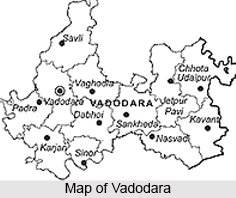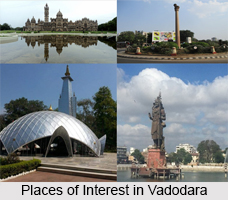 Formerly known as Baroda, Vadodara is the third largest metropolis and city in the Indian state of Gujarat with a population of 2 million people as per the Census India reports of 2011. Stretching over an area of almost 400 sq. km, the city of Vadodara is situated on the banks of the Vishwamitri River. It is the administrative headquarters of the Vadodara district.
Formerly known as Baroda, Vadodara is the third largest metropolis and city in the Indian state of Gujarat with a population of 2 million people as per the Census India reports of 2011. Stretching over an area of almost 400 sq. km, the city of Vadodara is situated on the banks of the Vishwamitri River. It is the administrative headquarters of the Vadodara district.
Etymology of Vadodara
Known as the Sanskari Nagari or the Cultural City of India, there have been several names assigned to the city of Vadodara over the ages. Under the reign of Raja Chandan of the Dor tribes of Rajputs, the city was called Chandanavati. Eventually it got changed to Virakshetra or Viravati, which means the Land of Warriors and later on it was known as Vadpatraka. The word Vadpatraka is a distorted form of the Sanskrit word "vatodar", which means in the belly of the Banyan tree. The exact time period for these changes are not recorded but early English travellers and merchants mention the town as Brodera and from here the name Baroda is derived. Finally, in 1974, the official name of the city was changed to Vadodara.
History of Vadodara
With a rich historical background, the first recorded history of the city dates back to 812 A.D, when the first settlers lived on the banks of the Mahi River, which formed the flood plains in the region. Excavations have revealed remnants of human settlement on the right bank of the Vishwamitri River on a group of dunes resting on the alluvium of the river which dates back to 1000 B.C. It also ascertains the existence of the Stone Age Era.
Until 1297, the province of Vadodara was mainly dominated by the Hindus, with the Gupta Empire being the first Hindu rulers to rule over the region in the early years. Eventually, the region was taken over by the Chalukya dynasty, who was overthrown by the Delhi Sultanate. The Mughal Emperors reigned over the region for a long time until they were overthrown by the Marathas.
Geography of Vadodara
Located in western India, Vadodara is the 18th largest city of India and stands at an elevation of 39 m. Located in central Gujarat; the city of Vadodara is on the fertile plain between the Mahi and Narmada Rivers. According to the Bureau of Indian Standards, the metropolis falls under seismic zone- III, in a scale of I to V, in order of increasing proneness to earthquakes.
 Climate of Vadodara
Climate of Vadodara
The city of Vadodara has a semi arid climate due to its high potential evapotranspiration. The months from March to July sees a rise in temperature with the maximum average temperature being 40 degree Celsius, while the minimum being 23 degree Celsius. The cold winter months of November to February has a maximum average temperature of 30 degree Celsius and the minimum being 15 degree Celsius. From mid June to mid September, the southwest monsoon brings a humid climate. Despite the roughly 800 mm of precipitation that the city receives annually, the average rainfall is 93 cm. But infrequent torrential rains cause the river to flood and end up causing devastating disasters like the 2005 Gujarat flood or the 2008 Indian floods.
Economy of Vadodara
Vadodara always counted as cultural and educational area till the year 1960. Only few industries such as Alembic Pharmaceuticals, Sarabhai Chemicals and Jyoti were running at that time. But by 1962, there were 288 dominating factories of Chemical industries, Pharmaceuticals cotton textiles and machine tools employing 27,510 workers. The discovery of oil and gas in Ankleshwar led to the industrial development of Gujarat in a big way.
The Vadodara region is the largest beneficiary in the process of industrialization. Gujarat Refinery being a basic industry made a vital contribution on several fronts of regional and national levels. Other than various public sector enterprises, a number of large-scale industries have come up in private sectors. The establishment of large-scale industrial units in this region automatically brings into existence a number of smaller enterprises.
Government in Vadodara
Vadodara is administered by Vadodara Municipal Corporation (VMC). Some of the regions surrounding the city are administered by the Vadodara Urban Development Authority. The VMC was established in July 1950 under the Bombay provincial Corporation Act, 1949.
The city was divided by 4 zones and 26 wards. From each ward, 3 corporators are elected who in turn elects a mayor. The executive powers are vested in the municipal corporation, who is an IAS officer appointed by the Gujarat State Government. The mayor is responsible for day to day running of the city services. Vadodara city police are headed by a police commissioner, who is an IPS officer and maintains law and order in society.
Demographics of Vadodara
As per the Census India reports of 2011, the total population of the city of Vadodara was 1,822,221, out of which male and female are 869,647 and 801,159 respectively. Children below 6 years old constituted 9 percent of the total population. The literacy rate of the city is 94.5 percent. Apart from Gujaratis and Marathis, a significant population of North Indians, Rajasthanis, South Indians and Bengalis have settled in the city. Various languages like Gujarati, Urdu, Marathi, Hindi and English are spoken by the people of the city.
Culture of Vadodara
A cultural hub, Vadodara is known to have great museums in palace grounds such as the Maharaja Fateh Singh Museum and Art Gallery are unique and carry artefacts from around the nation and the world. There are few Gujarati studios and old style movie theatres in addition to the newer multiplexes to entertain all types of people.
Diwali, Uttarayan, Holi, Ganesh Chaturthi, Eid, Christmas and New Year are celebrated with great enthusiasm. Navratri is the city`s largest celebrated festival. In the month of October many of the residents spend their evenings at their local Garba grounds where local musician play traditional music and people revel in dance the Rass and Garba dance. Large numbers of international tourists come every year only to take part in the Garba dance.
Places of Interest in Vadodara
The city of Vadodara has various tourist attractions starting from temples to palaces. With a vibrant history related to art and architecture, the city of Vadodara is also known as Kala Nagari or Art City. Some of the remarkable places to visit are the famous palaces like the Laxmi Vilas Palace, Nazarbaug Palace and Makarpura Palace, which showcase stunning art and architecture. Then there are the monuments, temples, museums and gardens like the Kirti Mandir, Kirti Stambh, Nyay Mandir, Dakshinamurthy Temple also famously known as the EME Temple, the Maharaja Fateh Singh Museum and the Sursagar Lake.
Visiting Information on Vadodara
The city of Vadodara is known as the Gateway to the Golden Quadrilateral because of it being on the major rail and road arteries joining Mumbai with Delhi and Ahmedabad. The city has its own airport called the Vadodara Airport and its own junction railway station.



















